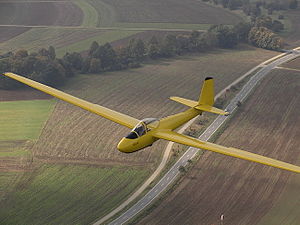Letov XLF-207 Laminar
| LF-107 Luňák | |
|---|---|
 |
|
| Role | Aerobatic glider |
| Manufacturer | Letov |
| First flight | 25 June 1948 |
| Number built | 75 |
The LF-107 Luňák (English: Kite) is a Czech aerobatic glider designed by Rudý Letov in the late 1940s. The design was developed within a prolific group of aeronautical engineers and sailplane pilots including K. Dlouhý, J. Matejcekm, and B. Bocek.
The first flight of the prototype took place on June 25, 1948 and a second prototype flew in July. The prototype participated later in the same year in an aerobatic competition in Grenchen, Switzerland, and in Ziar, Poland in 1949, where its good aerobatic and gliding characteristics drew considerable attention.
Unfortunately the serial production was disrupted by geopolitical developments, as the factory was charged with production of MiG-15, MiG-19 and MiG-21F aircraft and the access to Western civil export markets was progressively hampered by the emergence of the Iron Curtain. Therefore, only 75 examples of the Luňák were produced in all.
In 1950, a variant with simpler construction and a revised cockpit, among other changes, was developed. This LF-107 Luňák of wooden construction, designated Letov VT-7 under the military training system, was instrumental in the development of gliding and aerobatics in the Czech Republic. The LF-107 was also used for aerobatic training in the Soviet Union, Bulgaria, Romania and Poland.
The Letov XLF-207 Laminar, a derivative of the Luňák, holds the distinction of being the first glider in the world to have a laminar flow wing. Its maiden flight took place in Praha Letnany in August 1951. Research into laminar flow wings was carried out by the XLF-207 Laminar, a LF-107 fitted with laminar flow wings. Presently there are only nine airworthy Luňák, of which two are in the United Kingdom. A Luňák is displayed in the American Museum of Flight.
Data from
General characteristics
Performance
...
Wikipedia
